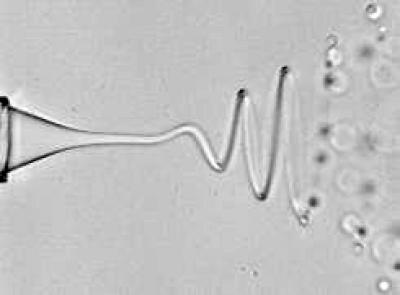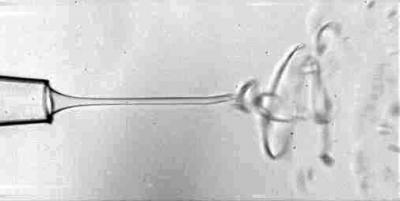While producing a whipped jet in a viscous dielectric material – polydimethylsiloxane oil – the researchers were surprised to see the chaotic motion switch over to a steady-state helical structure.
"We were able to stabilize the structure associated with the whipping behavior and found that the stable structure is a helix with a conical shape," said Fernandez-Nieves. "You can picture it as a conical envelope, and inside the envelope you have a helix. Once the viscosity of the outer liquid is sufficient, you stabilize the structure and get this beautiful helix."
Georgia Tech postdoctoral fellow Josefa Guerrero used a high-speed, microscope-based video camera operating at 50,000 frames per second to study the waveforms emerging from the experimental jets, which were less than five microns in diameter. The video allowed precise examination of the waveforms produced when the liquid flowed out of the glass needle and into the second liquid flowing around it.
Working with collaborators Javier Rivero-Rodriguez and Miguel Perez-Saborid at the University of Seville, the Georgia Tech team – Fernandez-Nieves, Guerrero and former postdoctoral fellow Venkata R. Gundabala – used hydrodynamics theory to help understand what they were seeing experimentally.
"By developing the model, we were able to balance the importance of the different forces in the experiment," explained Fernandez-Nieves. "The helix was part of the solutions in the model and it reproduced some aspects of the experimentally observed helices."

This video show jets emerging from the same glass needle in chaotic whipping (left) and a steady state helical whipping. By controlling the viscosity and speed of the liquid surrounding the jet, researchers are able to control chaotic whipping to create this steady-state.
(Photo Credit: Georgia Tech)
Once the jets were stabilized by the viscous secondary liquid, the properties of the helix were controlled by the electrical charge. In the experiment, the researchers applied approximately 1,000 volts to generate the jets.
"We learned that the outer fluid plays a major role in stabilizing the structure of the jets," Fernandez-Nieves added. "Once the structure is stable, the details of the properties of the helical structure depend on the charge."
Ultimately, the stable jets break up into spherical droplets. The researchers have not yet formed fibers with their experimental setup.
In future work, Fernandez-Nieves hopes to study other waveforms that may be produced by the system, and evaluate how controlling the liquid jets could improve industrial techniques used in fiber production and electro-spray processes that generate clouds of droplets.
"We are interested in trying to map out those different behaviors," he said. "For us as physicists, this is interesting because it allows us to explore, address and measure things that nobody could look at before in the way we can today. We are anxious to understand the applied impact."

This image shows a jet exhibiting a steady-state helical whipping as it emerges from a needle in a microfluidic device. By controlling the viscosity and speed of the liquid surrounding the jet, researchers are able to control chaotic whipping to create this steady-state.
(Photo Credit: Georgia Tech)

This image shows a jet exhibiting chaotic whipping as it emerges from a needle in a microfluidic device.
(Photo Credit: Georgia Tech)
Source: Georgia Institute of Technology